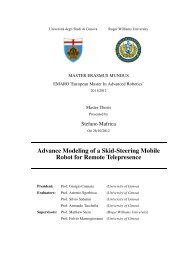CAMPUS PLANNING - Roger Williams University
CAMPUS PLANNING - Roger Williams University
CAMPUS PLANNING - Roger Williams University
You also want an ePaper? Increase the reach of your titles
YUMPU automatically turns print PDFs into web optimized ePapers that Google loves.
2002-2003 RWU Presidential Fellowship Report: Campus Planning<br />
• Identify / Test Strategies<br />
• Develop Alternatives<br />
• Choose Direction<br />
• Develop Final Plan<br />
• Develop Guidelines<br />
In order to assist in this process, a number of exercises<br />
where undertaken which allowed the students to explore the<br />
entire range of scalar relationships. We started with a series<br />
of loose collage exercises that allowed the students to gain<br />
an intuitive understanding of the structure of the campus.<br />
The strategies that emerged where tested and developed at<br />
a schematic level. Thirty studies were reduced to three<br />
basic strategies with variations. Precinct plans were then<br />
developed to test strategies and explore alternatives at a<br />
scale between that of the individual building and that of the<br />
Campus. These studies then informed the testing, selection<br />
and development of two final schemes. This movement<br />
between scales and modes of investigation was critical to<br />
the development of the final plans.<br />
institutional memory and values. The particular demands of<br />
the end users, of facilities or other imbedded interests must<br />
be in dialogue with the established principles shaping the<br />
whole. At the most mundane level the implementation<br />
phase involves the following:<br />
• Establish project committees (sub-committees)<br />
• Develop Precinct Plans<br />
• Review Building and Landscape Design Proposals:<br />
- Review Programming<br />
- Design Process: Concepts, Schematic Design,<br />
Design Development, Final Documentation<br />
• Manage Costs<br />
6. Implementation<br />
Continuity of process allows for continuity of the built<br />
environment. The Campus should not be viewed as a<br />
collection of disparate projects, but as “The Project” with a<br />
series of interdependent pieces, each of which answers to<br />
the whole. This requires communication and shared<br />
understanding among the various parties participating in<br />
the shaping of this larger environment. The “design<br />
authority” is instrumental in the communication of<br />
15
















